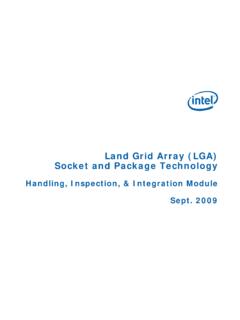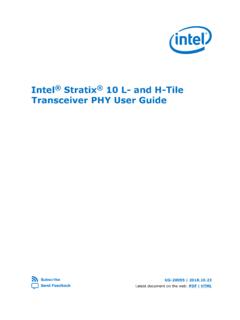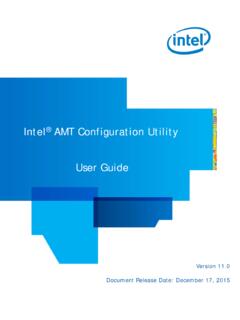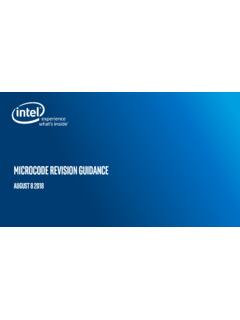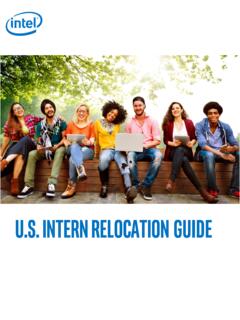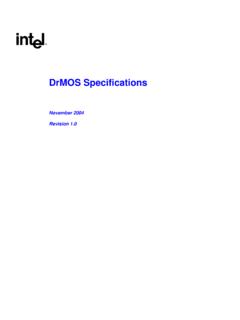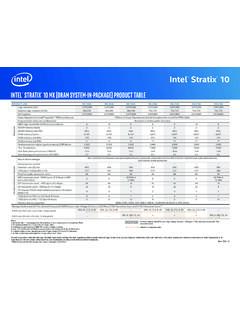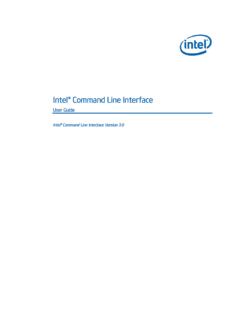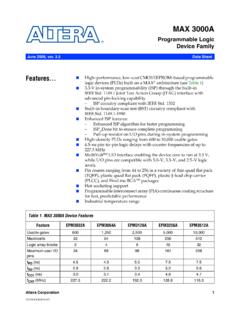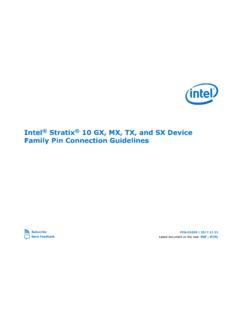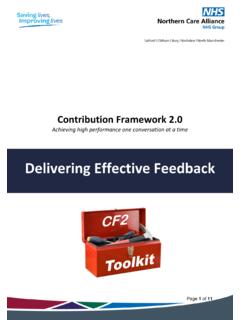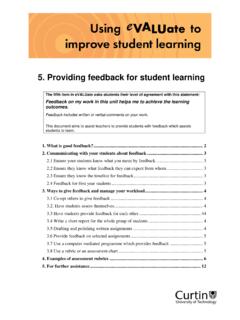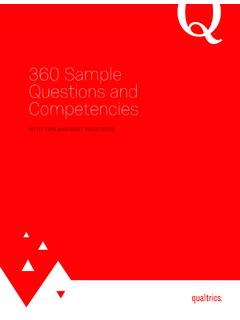Transcription of Instructional Strategies: Teacher and Peer Feedback
1 Intel Teach Program Designing Effective Projects Copyright 2012 Intel Corporation. All rights reserved. Page 1 of 2 Instructional Strategies: Teacher and Peer Feedback Providing Feedback to Students Feedback enhances student achievement by highlighting progress rather than deficiency. With progress Feedback a student is given opportunities for checking-in with the Teacher and multiple opportunities to ask questions. Students answer the following questions during progress Feedback : Am I on the right track? What improvements can I make? What am I doing well? How am I doing overall? With progress Feedback a student will be able to successfully self-monitor, have higher aspirations for further achievement, greater self-satisfaction, and higher performance overall. By taking the time to sit down with a student and offer constructive criticism, give necessary help, offer suggestions, and provide positive Feedback , teachers can positively impact student learning.
2 Marzano, Pickering and Pollock (2001) cite providing Feedback as one of the nine effective classroom strategies in their book, Classroom Strategies that Work: Researched-Based Strategies for Increasing Student Achievement. Effective Feedback should: Be corrective in nature. Feedback should provide students with an explanation of what they are doing correctly and what they are doing that is not correct. Be timely. Immediate Feedback is necessary in order for it to be the most effective. Be specific to a criterion. Feedback should reference a specific level of skill or knowledge and not be norm-referenced. Allow students to provide their own Feedback . Students should be able to effectively monitor their own progress through self-evaluation based on the Feedback given by the Teacher . Feedback can be informal or formal. With informal Feedback , teachers can drop by students desks and comment on their work.
3 With this type of Feedback students receive instantaneous suggestions and can make immediate changes. With formal Feedback , students attend a conference with the Teacher where teachers check progress toward goals, discuss progress, and work with students to set new goals. Conferences help develop self-direction and protect students from the fear of failure. When students are given Feedback along the way, they are able to learn from their mistakes, make the necessary changes and achieve at higher levels. The best Feedback appears to involve an explanation as to what is accurate and what is inaccurate in terms of student responses. In addition, asking students to keep working on a task until they succeed appears to enhance achievement. (Marzano, p. 96) Learn About Peer Feedback Students value each other s opinions and ideas. In most cases, they enjoy working with one another.
4 If given the opportunity, students can give and receive important and valuable ideas from a peer. When set up correctly, structured peer-to-peer conferences give students time to get suggestions, ideas, and compliments on their work. When conferences are productive, students are aware of what to look for and have specific criteria to follow as they work with their peers. Evaluation guides or checklists can be handy tools to keep students on task and remind them to offer positive Feedback as well as suggestions and ideas. With practice and modeling, teachers can implement this strategy into the classroomIntel Teach Program Designing Effective Projects Copyright 2012 Intel Corporation. All rights reserved. Intel, the Intel logo, the Intel Education Initiative, and the Intel Teach Program are trademarks of Intel Corporation or its subsidiaries in the and other countries.
5 *Other names and brands may be claimed as the property of others. Page 2 of 2 at any time for a variety of purposes. Make it Happen in Your Classroom Teacher and peer Feedback can take place at any grade level and with any subject area. Embedding informal and formal Feedback into the classroom is an effective and worthwhile strategy. Learn about ways to implement this strategy into the classroom. Informal Teacher Feedback Check-ups and check-ins are used to see how students are progressing, answer questions, or help with ideas. Formal Teacher Feedback With the use of conferences, teachers can provide suggestions and comments along with individualized goal setting. Peer-to-Peer Feedback With the use of structured peer conferences students give and receive Feedback on their current work. Intel Teach Program Designing Effective Projects Copyright 2012 Intel Corporation.
6 All rights reserved. Intel, the Intel logo, the Intel Education Initiative, and the Intel Teach Program are trademarks of Intel Corporation or its subsidiaries in the and other countries. *Other names and brands may be claimed as the property of others. Page 1 of 1 Informal Teacher Feedback Making the Most of Informal Encounters Informal Teacher Feedback can take the place of many different forms. This type of Feedback is designed to give students on-the-spot responses to work they are immersed in at the time. The Teacher can use this time to answer questions, provide suggestions, or just check in with the student to see how they are progressing. Informal Feedback can be done in the form of: Periodic check ups Students are assigned a few minutes each day to check in with the Teacher and go over any questions or ideas they may want to discuss before continuing with the work A stop by a student s desk A short visit with a few students during a work period to check in on how they are doing, answer questions, and offer Feedback Written responses in a learning log or on the work itself Respond to students entries in learning logs or journals, pose questions, and offer ideas Write comments on tests, reports, papers, and other work products that prompt students to see mistakes and ask questions Allow students time to retake a test or find the right answers with some improvement to their original score Intel Teach Program Designing Effective Projects Copyright 2012 Intel Corporation.
7 All rights reserved. Intel, the Intel logo, the Intel Education Initiative, and the Intel Teach Program are trademarks of Intel Corporation or its subsidiaries in the and other countries. *Other names and brands may be claimed as the property of others. Page 1 of 1 Formal Teacher Feedback Student- Teacher Conferences Teachers can provide Feedback through structured conferences with specific goals. Conferences focus on suggestions and comments along with individualized goal setting on a formal level. Teachers can meet with a few students a day or a week depending on specific projects, deadlines, and individual student needs. It is important to set up these conferences in a structured way so both Teacher and student make good use of their time. Below is a list of helpful hints for setting up student- Teacher conferences. The Teacher should look at student work beforehand A checklist or Feedback form should accompany the work Comments should be specific to the work and elaborated on during the conference The Teacher should focus on two to three items that need work and be prepared to share examples on how to improve them Plenty of positive Feedback should be shared throughout the conference Time for the student to ask questions and give input should be allotted Student should be able to take the Feedback form/checklist with them at the end of the conference to use as a reference in making revisions The main goal should be to meet with the students two or more times during the course of a project.
8 This way, students are given multiple opportunities to make sure they are on the right track and make necessary improvements to their work. Using formal conferencing along with informal Feedback , students are protected from failure and set up for success. Designing Effective Projects: Teacher and Peer Feedback Teacher Feedback Form Student name: _____ Title of work: _____ Conference time: _____ 1. Some things you did successfully: _____ _____ _____ 2. Some things you could improve upon: _____ _____ _____ 3. Next steps: _____ _____ Note: Keep this Feedback form to refer to as you revise your work. Intel Teach Program Designing Effective Projects Copyright 2012 Intel Corporation. All rights reserved. Intel, the Intel logo, the Intel Education Initiative, and the Intel Teach Program are trademarks of Intel Corporation or its subsidiaries in the and other countries.
9 *Other names and brands may be claimed as the property of others. Page 1 of 1 Peer-to-Peer Feedback Peer Conferences With the use of structured peer conferences, students give and receive Feedback about ongoing work. The most important component of peer Feedback is the modeling that occurs beforehand. It is imperative that teachers model and role play how to give Feedback in a constructive way before having students meet on their own. Set out on their own to give Feedback , many students will use the time to chat, criticize the other students work or get nothing done. Students need to be held accountable for the comments, suggestions, and Feedback they are giving one another and need to know ahead of time how to do this effectively. Providing students with a peer Feedback form, which will be checked by the Teacher , can provide structure to peer conferences.
10 Once students have had time to practice, know what the requirements are, and are aware of expectations, peer conferences can be an integral part of the Feedback process. Peer Feedback can be done at any time during the course of a project. It can be used as a starting point to get ideas, or can be structured to give students Feedback in the middle of the project so they can revise their work based on their peers input. It can also be helpful to get peer Feedback before a Teacher conference, so the work is more refined and has been looked at by others. Peer Feedback can be given at multiple stages during a larger project or during the course of a written project that uses the writing process steps. A peer Feedback form is needed so students are focused on giving the right kinds of Feedback and know what the expectations of the conference are.
